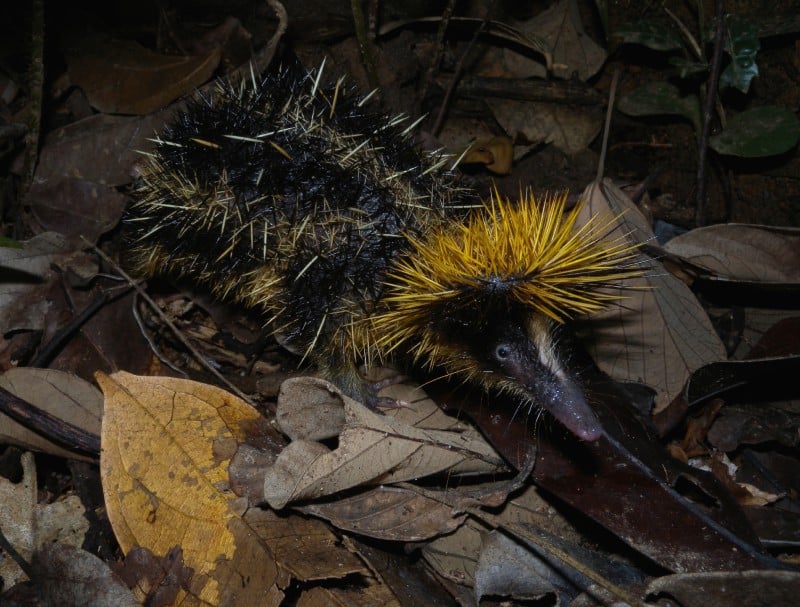
Lowland Streaked Tenrec Facts
- The informative term of Lowland Streaked Tenrec serves as the most frequently used title for this highly distsinctive mammal. For the moment, it has no other broadly accepted general name. Though not unknown, that’s somewhat uncommon.
- Within the scientific community, though, it has another name by which it’s known. That, however is a term almost impossible for the majority of laypeople to pronounce. That’s because this marvel holds the technical moniker of Hemicentetes semispinosus.
- The animal received this tongue-twisting appellation due to the efforts of Jean Léopold Nicolas Frédéric, Baron Cuvier. He accomplished the first recognition of it as a separate and distinct species. He managed that noteworthy deed in the year 1798.
- Fortunately, the amazing Lowland Streaked Tenrec seems to be maintaining a stable and sufficient population base. That situation further appears to hold true throughout its native range. The IUCN therefore currently lists it as Least Concern on its Red List.
- It nevertheless faces some potential threats to its existence, at least. Many of these stem from the actions of mankind. Habitat loss due to deforestation tops that list at present. Looming large, though, is the ever-growing threat posed by climate change.
Related Articles
Lowland Streaked Tenrec Physical Description
Along with its distinctive appearance, the Lowland Streaked Tenrec developed as a comparatively diminutive animal. Adults attain an average length of head and body of about 6.5 in (16.5 cm). It also stays quite light, rarely exceeding 7 oz (200 grams) in weight.
It also stands out from related creatures in yet another manner. Unlike many mammals, it displays no notable degree of the physiological characteristic of sexual dimorphsim. Distinguishing the genders can therefore be difficult for the untrained observer.
Among mature individuals, body mass frequently varies quite significantly. This occurs without regard to gender. Overall, the species attains an average weight that ranges from 4.4 – 9.9 oz (125 – 280 g). Though rare, exceptional specimens do sometimes occur.
The snout of the Lowland Streaked Tenrec develops as elongated, while the tail appears vestigial. The head, back, and sides of the animal display a black shade, with yellow stripes. Meanwhile, the underbelly typically displays a chestnut brown and covered with soft fur.
The rest of the body is covered with numerous long, sharp quills. It’s also important to note that some of these develop as barbed and detachable, being used in defense. These develop most numerous on the crown of the head. It’s also the quills that are used for stridulation.
- Kingdom: Animalia
- Phylum: Chordata
- Class: Mammalia
- Order: Afrosoricida
- Family: Tenricidae
- Genus: Hemicentetes
- Species: H. semispinosus
Lowland Streaked Tenrec Distribution, Habitat, and Ecology
The Lowland Streaked Tenrec evolved as native to an extremely restricted section of the globe. Given its unique nature, where it lives likely comes as no surprise to many. That’s because it developed as endemic solely to the island of Madagascar, located near Africa.
Even there, though, it only appears in a limited section of this already constricted range. Presently, the mammal only lives on less than half the total area of the island. The zones it lives in roughly forms the approximate northern and eastern regions of the whole.
Like many related species, it displays decided preferences regarding its choice of habitat. In its case, the animal lives almost exclusively in sections composed of tropical rainforest. It also shows a fairly strong favoritism for lower altitudes, rarely dwelling at higher one’s.
Within these restrictions, however, it does show some flexibility, at least. On occasion, individuals manifest a fondness for splashing in shallow bodies of water, such as puddles. It also often makes its home in proximity to other bodies of water, such as ponds or lakes.
The Lowland Streaked Tenrec evolved as omnivorous in nature. It primarily consumes animal prey, though, especially earthworms. Other small invertebrates also serve as a food source. Yet it eats smaller quantities of various fruits on occasion, too.
The intriguing animal typically constructs long, shallow burrows in which to dwell. One often holds several families. These rarely reach more than 6 in (15 cm) beneath the surface, though. Its principal predators include the Fossa and the Malagasy Mongoose.
Species Sharing Its Range
Comet Moth Rosy Periwinkle Gray Mouse Lemur
Check out our other articles on Gray Mouse Lemur, Red Crested Tree Rat, Bandicoot, 6 Mysterious Natural Phenomena, Orange Jewelweed, Mangrove Monitor
